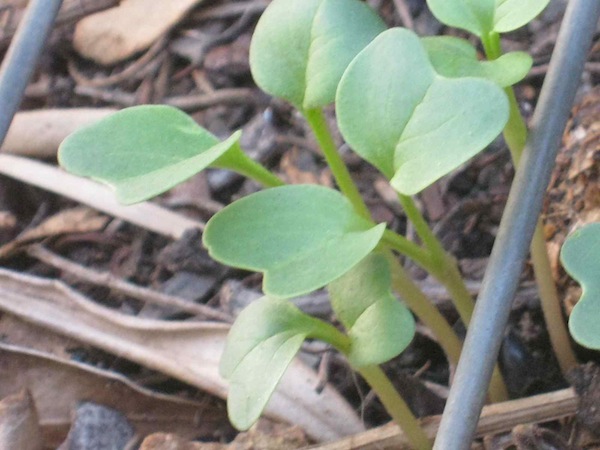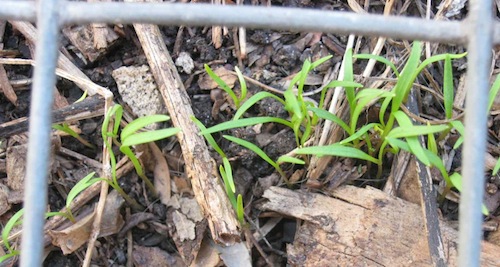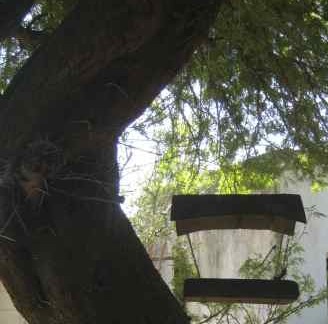Dear Reader, in this age of AI created content, please support with your goodwill someone who works harder to provide the human-made. Sign up at the top of the lefthand column or bottom of this page. You will receive my hand illustrated monthly newsletter RESTORE NATURE and access to the biodiversity garden design course as I write...and nothing else, I respect your time. I am also removing the advertizing as best I can as its become intrusive inappropriate and pays me nothing.
How to stop birds scratching out your seedlings
the gentle bird friendly way
This summer we had quite a problem with birds scratching in our vegetable patch and uprooting seedlings and grown plants.
We’ve also had to deal with a long drought, a memorable and exceptional drought that dominated local facebook threads for months, and our drinking water is running out. The dryness of the soil and the hunger of the birds may have worsened the problem. They would leave the beds pitted and in disarray, and we’d find the seedlings wilted, dying in the blazing sun, lying at a distance from where they had been, but many were buried in the process. We suspected the thrushes, as they we can see these birds scratching like chickens in the rich compost we mulch the beds with. The birds also seemed to like emptying the plant pots containing our chilis. Recently I found a whole adult basil bush about 70 cm high, lying on its side with its root ball exposed. I quickly dug it in again and surrounded it with bricks to weigh down the roots and conserve water, and it is still living. However, I think only a very large bird could have done this, and I suspect the Hadeda or ibis that has been visiting us recently, with its 6 inch rapier like beak.
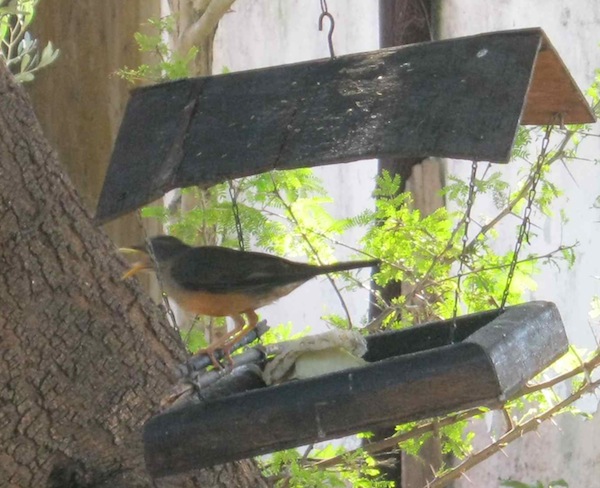 our thrush when he is not scratching up my seedlings
our thrush when he is not scratching up my seedlings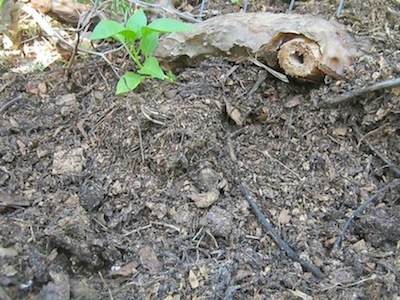 what is left of a neat row of chilis after the birds scratching in the area
what is left of a neat row of chilis after the birds scratching in the areaWhat to do about birds scratching in your plant pots
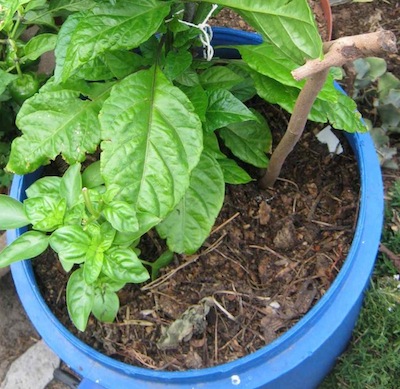 a seedling vulnerable to birds scratching a seedling vulnerable to birds scratching |
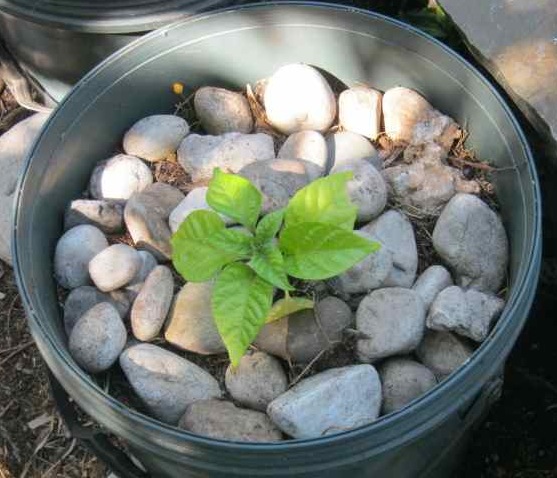 how to stop birds scratching with pebble mulch how to stop birds scratching with pebble mulch |
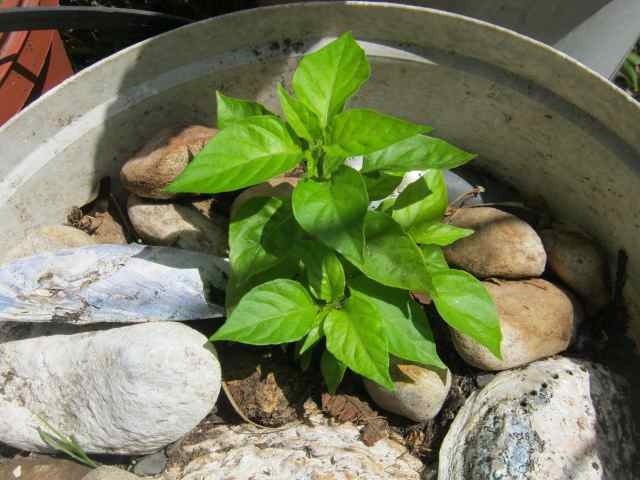 |
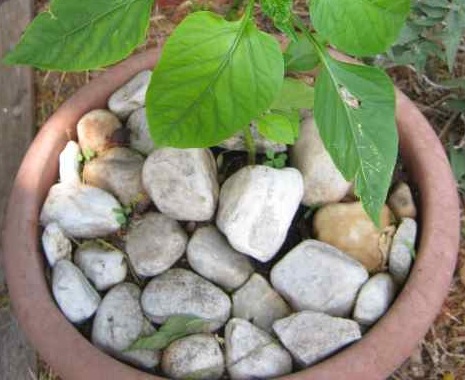 |
Because of the bird damage we tried a number of things to stop birds scratching in the vegetable patch, and in our plant pots. The strategies successful in protecting the potted chilis was to surround the plants with spoon sized beach pebbles, or large abelone shells, and to fill every gap with other conical shells with their points stuck upward. For seedlings, sowed direct in the ground, wire mesh or chicken wire laid flat on the ground has served well, but I do not know what to do when the seedlings are larger and we have to remove the mesh so that they can grow freely, and do not become trapped in it when we harvest (they are root crops). For seedlings grown in six packs we used our own version of netting on a frame.
Stop birds scratching seedlings from the ground
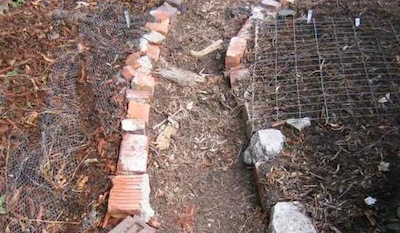 mesh laid on the ground to stop birds scratching out emerging seedlings
mesh laid on the ground to stop birds scratching out emerging seedlingsI’ve been forced to do more research to see what other people do, and after comparing various sources, I was able to review, in a nutshell, the measures to stop birds scratching and divide them into major categories, namely scaring them off, excluding them from contact, deterring them, confusing them, not attracting them in the first place, and finally acceptance of birds as a necessary nuisance, because of the benefits they bring the gardener in natural pest management.
On the net, people can get fanciful, as well as creative, and I found some answers to my problems. I don’t approve of some of the methods, such as confusion, which consists in scattering whiskey soaked corn on the ground ! I shudder to think of the damage a drunk bird could do when they are so destructive sober. Just joking. Its cruelty to animals, a big no no.
Scaring birds silly to stop them scratching
Scaring the birds is counter productive, gardeners need them to eat insect pests, and I delight in ‘my’ garden birds every day, and pleasure is as important as the daily intake of minerals and nutrients, to keep us healthy. Techniques for scaring birds that I found mentioned but can’t bear to try out will follow. Try a mechanical rotating owl with screeching soundtrack, strings with shimmering windblown aluminium foil strips every 40cm, CD’s or bottle tops hanging from lines or stakes (the consensus seems to be that these are useless to ho-hum, but alternative narratives are welcome), mirrors strategically placed to frighten the bird with their own reflections, pie tins or metal kitchen utensils that clatter together when the wind blows, audio players with recorded predator sounds, including birds of prey, wind chimes hung above seedlings, shopping bags rustling on stakes (though sparrows apparently nick them for nesting !), keeping the birds on their toes (sorry… did you say toes ?) by constantly changing the location of your shiny balloons, with shiny tape trails, scarecrows, radios, flashing eye balloons, artificial snakes, stuffed magpies, scary masks, large eyed balloons, owl silhouettes, children’s whirly gigs, crime tape (I ask you) and last but not least drenching them with irrigation sprayers, all of these paint a picture of jittery stressed out birds, ready to be carried off to some avian sanatorium. Drunk birds are bad enough, do you really want unstable angry birds in your garden ? It sounds like the creation of terrible karma to me.
The strategy of acceptance:
love 'your' birds
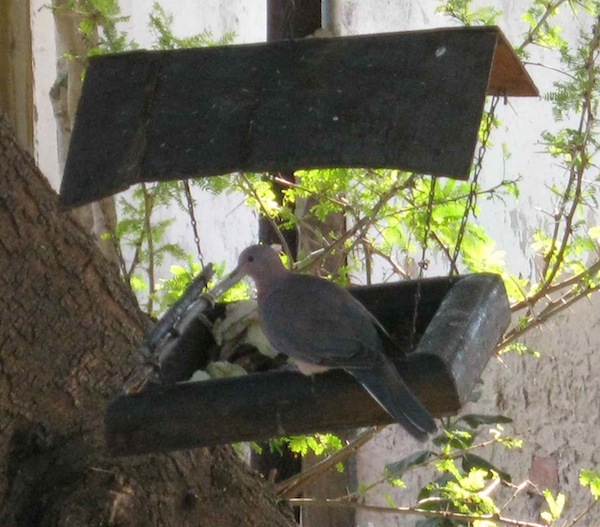 At Chez la Colombe we prefer a peaceful table
At Chez la Colombe we prefer a peaceful tableI don’t want to scare anything, I’ve had enough scares in my life ! I cannot relish the thought of stressed feathers. I need a solution that does not keep them out of my garden, but only out of a small vulnerable area of the garden.
Thus as effective measures I’m hovering around deterrents, exclusion, not attracting them to scratch in the first place, and adding a healthy dose of acceptance. Taking these in reverse, we have a relatively trouble free garden and I think ‘our’ birds play a major role in keeping it that way. Its small, about 300 square metres, but we have a bird hotel (Acacia karoo) and restaurant (bird feeder supplied with scraps and seeds and other food daily). Thus we have regulars who are permanent hotel residents, a weaver with productive nests and harem, two or three nesting doves, sparrows of two kinds, thrushes (the culprits …say no more), pigeons and white eyes, and we also are blessed by occasional visits from traveling collared sunbirds, mouse birds, finches, starlings, wagtails .. and yes, the intimidating Ibis, and we even have rare visits from even stranger folk, blowing in from deep in the desert, or escapees from aviaries. It’s a lively scene we have going. I cannot really begrudge our visitors the odd grub.
However, I wish they could take these without killing our own potential grub in the veggie patch. Gentle management is the key here. We do not want to make our guests feel unwelcome and seek out another establishment. As a trick to stop birds scratching out our seedlings, not attracting them is going to be hard. Our garden seems to encourage bird scratching like a rash, or like a magnet attracts pins. We’ve had a vermiculture business for over a decade and love making other kinds of compost and producing no waste, so the thickly mulched beds are an open invitation. The suggestion online to mature the compost more thoroughly and exclude worms is just not possible. The only thing we can do is stop birds scratching where current plant production is under way, and leave them to have fun everywhere else.
Stop birds scratching in your seed trays
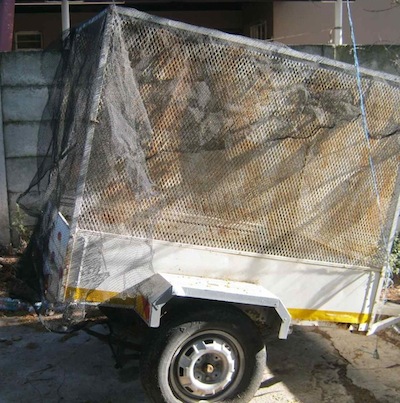 a net over the trailer protects our seeds germinating in six packs from birds scratching out the seedlings
a net over the trailer protects our seeds germinating in six packs from birds scratching out the seedlingsWe had ourselves formed three exclusion strategies, basically paving the soil in our chili pots, putting a mesh of wire or a ‘prison’ on the ground that makes scratching impossible, and placing our six packs in the trailer under a net. I still am in need of a way to protect plants growing in the ground. I found that ours were far from the only solutions, and many an approving nod was earned by the pea-sticks strategy.
Pierce the area where your seeds or your seedlings are located with sticks leaning in all directions and in such a thick ‘forest’ that it prevents birds scratching. These can be twenty centimetre pea sticks, but some folk insert longer sticks, finding that a mix of branching and curved sticks are extremely effective at protecting young corn and repelling birds who simply pluck out the sticks and do their thing. Perhaps the branched sticks poke them as they advance. We have thorny twigs from the Acacia karoo, Carissa macrocarpa, and African apricot. They have been effective against bird and cat damage, as well as deterring our friend Oyster from lifting his leg or defecating and scratching in our food garden. The disadvantage of sticks, that they only last for three years is something I can sneeze at. I have a more sticks than I know what to do with. But we simply do not have enough thorns to cover the whole vegetable garden thickly enough. Dry bracken or prickly wild grasses poked into the ground higgeldy piggeldy also serve the same purpose of preventing birds scratching, as do hollow polyethylene pipes used like the sticks. Pipes are apparently hard to drive into the ground unless the ends are cut at a forty five degree angle and you twist as you go. The advantage of piping in it lasting a lifetime and quantities produced being determined by yourself, rather than your garden, is for me outweighed by the expense, the lack of using renewables in the form of sticks that I have a surplus of and their sheer ugliness.
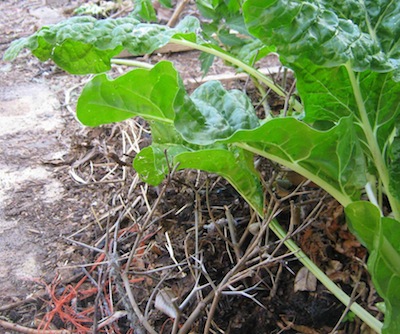 our chard among thorns: to prevent animals and birds scratching out our seedlings
our chard among thorns: to prevent animals and birds scratching out our seedlingsYour strategy very much depends on the scale of farming you
are doing. On a minute scale you can use disposable cups to cover seedlings,
but they remain vulnerable thereafter. Milk crates or plastic bottles as
cloches also protect a small area of soil, as do cones of stiff fly screen
netting, chicken wire cloches, and large stones mulching around stick teepees.
Barriers laid on the ground like mesh, prickly plants and low 3 cm mesh on frames
can protect several metres of space. Bird net laid directly on the ground and
weighted with stones, black mesh gutter guard rolls, frost cloth on frames
(with the added benefit of prevent sunburn on lettuces), net tunnels made of more
open bird netting or quarantine netting (which keeps everything out), tunnels
of cheap, light plastic tubing on a V-shaped tent, or curved hoops, the plastic
covered with protective mesh, domed wigwams made by tying a cross of two
flexible poles at the centre and driving the ends into the ground, all of these
can cover more area. You can fasten the net into the ground with bent wire, or
u shaped wire, and make the frames of bamboo, stakes or polythene tubes.
Useful to prevent birds scratching on large or small scale
plots are various harmless deterrents. Plant posts in the bed and span with criss
crossed fishing line or black thread, thick twine low to the ground also deters
cats.
Tall surrounding weeds keeps blackbirds out of the rows,
claims one correspondent, on an interesting forum, but this and all the clever methods and tricks remain
to be tested. I know only that a mulch of pebbles, thorny branched sticks laid flat
on the ground, and wire mesh laid on the soil have worked for me during the
early stages of nurturing seedlings. As they grow larger I may protect the
adult plants with stakes larger than peasticks. These can double as staking for
tomatoes, legumes and small cucurbits, and create partial shading of the ground
in our next scorching summer, AND in the fashion of good permaculture theory, storey
the plants for maximum productivity per area of land.

Restore Nature Newsletter
I've been writing for four years now and I would love to hear from you
Please let me know if you have any questions, comments or stories to share on gardening, permaculture, regenerative agriculture, food forests, natural gardening, do nothing gardening, observations about pests and diseases, foraging, dealing with and using weeds constructively, composting and going offgrid.
------
home page for links to natural gardening know how
------
vegetable gardening the eco sensitive way
------
dealing with insects in the garden
You’re a home gardener ! Share your experiences and questions !
We all know about home gardening. Tell us about your successes, challenges and ask about issues that bother you. You may have the luxury of a back garden, but there are other ways we learn. Few people age without growing something or buying vegetables during their lives ! It is absolutely guaranteed that you have learned things which can help others on their gardening journey.
We invite you to share your stories, ask questions, because if a thing has bothered you it will bother others too. Someone may have a solution ! No question is too small. There is learning for everyone involved, for you, for me (yes, I learn from every question), for us all. Exciting stuff !
We are starting on a new journey. Every week we will profile your letters ! The best stories and questions we receive.
What Other Visitors Have Said
Click below to see contributions from other visitors to this page...
SUCCESS ! Not rated yet
Here is some follow up on placing the wire grids on the ground just after sowing seed. The plants have come up beautifully. Close by on the opposite side …
SEARCH
Order the Kindle E-book for the SPECIAL PRICE of only
Prices valid till 30.09.2023
Recent Articles
-
garden for life is a blog about saving the earth one garden at a time
Apr 18, 25 01:18 PM
The garden for life blog has short articles on gardening for biodiversity with native plants and regenerating soil for climate amelioration and nutritious food -
Cape Flats Sand Fynbos, Cape Town's most endangered native vegetation!
Apr 18, 25 10:36 AM
Cape Flats Sand Fynbos, a vegetation type found in the super diverse Cape Fynbos region is threatened by Cape Town's urban development and invasive alien plants -
Geography Research Task
Jan 31, 25 11:37 PM
To whom it may concern My name is Tanyaradzwa Madziwa and I am a matric student at Springfield Convent School. As part of our geography syllabus for this
"How to start a profitable worm business on a shoestring budget
Order a printed copy from "Amazon" at the SPECIAL PRICE of only
or a digital version from the "Kindle" store at the SPECIAL PRICE of only
Prices valid till 30.09.2023
